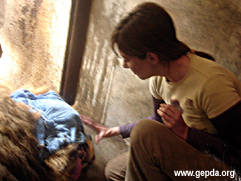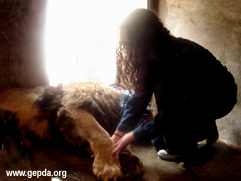WAS RESCUED BY GENTE POR LA DEFENSA ANIMAL
AND RELOCATED IN AN AMERICAN SANCTUARY.
|
|
Story of a rescue |
||||||||||||||||||||||||||
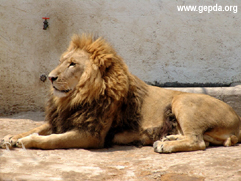
Kobú is 5 years old. Until now, he has spent his whole life in a 30 square meter cage. He has never been able to run and has never seen others like him. |
The first months of his life, he lived in a house in Cuernavaca, south of Mexico city. He was just another ornament in the yard. When he started to grow, his owners realized that it was imposible to keep him, and, as is sadly usual for wildlife sold as pets, he was confined in a cage on the grounds of a primary school, to be kept there for the rest of his life. Gente por la Defensa Animal received a report from a citizen about an African Lion (panthera leo) living inside of a well-known Catholic school, north of Mexico City. We corroborated the report, and saw that he lived in a cage with a cement floor, with only a dried-up tree for environmental enrichment. |
||||||||||||||||||||||||||
| To the school, we proposed to find a proper place for Kobú, so that he could have a good life. In that moment the 2 year relocation process for this great lion began.
Our first option for relocating Kobú was one of the big zoos in the State of Puebla or Morelos. But the recomendation was always the same: ”put him to sleep; lions reproduce easily and there are too many in captivity. No one is going to be interested”. Of course, we never saw that as an option, so we started a search in the US. We contacted some sanctuaries and all accepted as soon as they heard that Kobú was a Mexican lion. |
|||||||||||||||||||||||||||
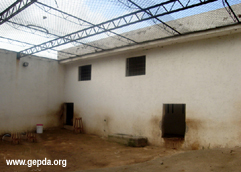
Place where Kobu lived form many years |
Finally, the Wild Sanctuary (formerly Rocky Mountain Wildlife Conservation Center), represented by Patrick Craig, founder and director, was the one who took him in. Patrick says, “We are aware of the lion situation in Mexico; animal welfare is a subject in which very few people there are interested. There are at least 40,000 lions living in horrible conditions and the authorities show no interest at all”. Kobú had no legal documents; we don’t know if he was bought on the legal or illegal market. Dealing with all the legal paperwork was very difficult, primarily because the authorities don’t care about animal discomfort during the inspection process. |
||||||||||||||||||||||||||
| We had to cancel the flight several times, due to the time Kobú would have had to spend in the crate: 24 hours, between leaving the school and boarding the plane. Later, he would have to bear a four-hour flight to Los Angeles, to pass through the required inspections in the US customs and then travel 14 hours more to Colorado. Too much time and stress for Kobú. At last, we found a way that the authorities in the United States could expedite the process. In Mexico, it was impossible: Kobú had to wait 14 hours in the airport to board the airplane, because the bureaucrats in charge of the inspections finish work at 3 o'clock in the afternoon. Patrick, director of the Wild Sanctuary, arrived at Mexico City on Thursday, June 22nd, at about 1:00 PM. We bought provisions so that Kobú could eat during the flight and we reviewed the plan for the following day. We started very early Friday morning: we got up at 4:00 AM and we headed to the school.. |
|||||||||||||||||||||||||||
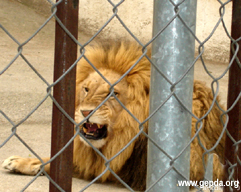
Kobú before being taken to the airport.. |
Kobu’s roars could be heard from a distance; our lion must have sensed that something was going on. When we arrived, his veterinarian, Eduardo Veyán, had already relocated him in a small room, without unevennesses or objects, so that he would be safe when the effect of the anesthesia began. Kobú was nervous - Pat explained to us that lions are great recognizers of faces; they are able to identify new faces immediately. Besides this, they can detect other males (including human males) and due to their territorial instinct they feel threatened by them – He was moving around very agitated. We saw him through a special orifice. It was impressive to have him so close, walking only a few centimeters from us. |
||||||||||||||||||||||||||
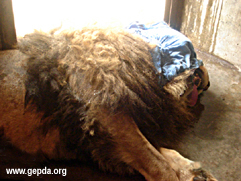
Kobu after being anesthetized |
He would be anesthetized by two soothing darts, so the anesthesia would not be so abrupt. At 7:50 AM he received the first dose and the second one 20 minutes later. In 40 minutes Kobú was sleeping.
When at last we entered the room, Kobú was asleep on the ground. His breathing had slowed down but it was still energetic. It is amazing the power he projected even lying there, unconscious. Our hearts were beating so fast and our legs were shaking. He is enormous. |
||||||||||||||||||||||||||
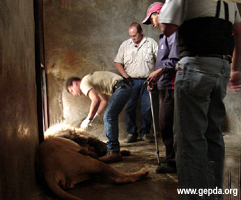
Kobú with his vet and Pat. |
The anesthetics make him hypersensitive, so the vet covered his eyes and ears. The vet’s team and Patrick proceeded right away: oral cleaning, vaccines and vitamins. |
||||||||||||||||||||||||||
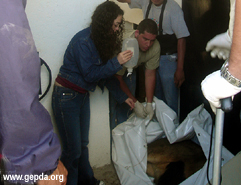
Karla helps while Kobú is taken to his cage.. |
After that everything happened so quickly: we put him in the improvised stretcher, carried him and put him in the crate, specially made for his journey. (The street dogs that live there were alarmed; they wanted to get close to Kobú, they seemed to be worried about him, despite rumors that they were part of his diet). Once Kobú was inside the trailer, the vet injected him with an antagonist, which would wake him up very slowly so when he would arrive at the airport he would have his five senses almost entirely with him. The international norms dictate that by security animals have to travel totally awake.. |
||||||||||||||||||||||||||
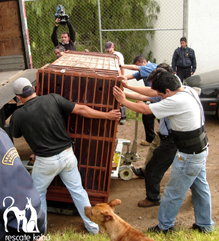
The media, passersby and even the stray dogs were watching the beginning of Kobú's journey to freedom |
The trailer was at the middle of a very busy highway. We were 30 minutes behind schedule and we had to get to the airport on time, because the Mexican authorities leave at 3:00 in the afternoon no matter what. We, along with all the other cars (people from the media, the vets, etc) were following the trailer, when suddenly the driver accelerated (I just can imagine Patrick’s face; he was in the trailer’s cab). I wonder if the driver, even though he was a close witness to the rescue, understood that he had a sensitive creature inside his truck and not a cargo of vegetables? We made a stop. Eduardo, the vet, immediately went into the trailer; Kobú was waking up from the anesthesia and was striking the walls of the crate as he tried to sit up. He told us that all was well and we continued the journey. |
||||||||||||||||||||||||||
| At some point on the highway, the driver switched to the side lane. He accelerated to 120 km/hr and we lost him. Fortunately, Patrick was with him. We (veterinarians, media and volunteers of Gente por la Defena Animal) had to find a way to arrive on time at the airport. Luckily, we found a better route and we arrived at the custom broker premises almost at the same time. More inspections and paperwork, and then back onto the road to reach the nearby airport hangars. The trailer entered the parking area and then we saw it drive off. After two years thinking about this moment, despite our happiness, we could not help but feel nostalgic. For Pat, things had just begun: he was with Kobú during the inspections, he had to deal with Mexican bureaucracy and with a logistics carrier that was of medium competence and not very sensitive towards animals (as the driver’s behavior showed).We talked to Pat serveral times during that afternoon. Kobu was calm; he ate and drank some water. At 4:30 AM they were almost ready to board the cargo airplane. They arrived in LA without major problems. On Saturday, June 23rd, at 1:30 PM Kobú entered the rescue trailer from the sanctuary to continue his long journey to freedom. He arrived at the Sanctuary on Sunday at dawn. It is going to take a while before he can be released. He has to be in a special enclosure separeted from the other lions, but he will be able to hear them roar and they will hear him roar back. Then, when the lion pride accept him (there is a complex communication code between them, through which Pat will know exactly when it finally happens), he will be taken closer to his new family, where they will be able to see each other. And the next step is freedom. We don’t know how long it is going to take; it could be weeks or even months. We want to be there on the day that our dear Kobú sees the wide open country with no bars in between. Find out more about Kobú's life in the Wildlife Sanctuary click here Read Kobú's journey from México to Colorado step by step.
|
|||||||||||||||||||||||||||

